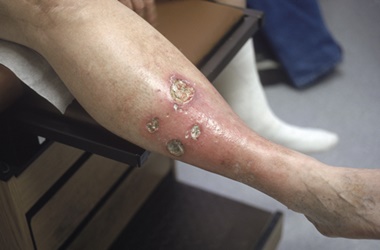Guideline: Prescribing for leg ulcers

The guideline
NICE has released guidelines with advice on antimicrobial prescribing for leg ulcers. It sets out a strategy for optimising antibiotic use and reducing unnecessary prescriptions, pointing out that while most leg ulcers will be colonised by bacteria, few become clinically infected.
Key points on prescribing for GPs
• Don’t take a sample from a leg ulcer for microbiological testing at first presentation.
• Only offer antibiotics if there are signs of infection, including redness or swelling extending beyond the ulcer, localised warmth, increased pain or fever.
• Offer antibiotics based on the severity of symptoms, the risk of the patient developing complications and previous antibiotic use.
• When prescribing for an infected ulcer, advise the patient to seek help if their symptoms worsen or do not improve over the next two or three days.
• Prescribe oral flucloxacillin 500mg-1g, four times a day for seven days as first line.
• If there is penicillin allergy, prescribe oral doxycycline 200mg on the first day, then 100mg once a day for the next six days.
• Prescribe oral co-amoxiclav 500/125mg, three times a day for seven days as second line.
• Reassess an infected leg ulcer if there is no improvement after two or three days or if the patient becomes systemically unwell or has severe pain.
• Consider sending a sample for microbiological testing, after cleaning the ulcer. Once the results are available, review the choice of antibiotic and change it if necessary.
Practical issues
GPs will need to make sure patients are given safety-netting advice so they are able to seek help if they become more unwell. GPs will also need to be vigilant about referral if the patient is at increased risk of complications because of comorbidities or immunosuppression, or does not respond to antibiotics, bearing in mind that the infection might not fully resolve until the course of antibiotics is finished. Make sure your practice and community nurses are aware of this guidance, too
Where to find it
NICE. NG152 Leg ulcer infection: antimicrobial prescribing. London, NICE, 2020
Please note: this first appeared in the April issue of Pulse
Pulse July survey
Take our July 2025 survey to potentially win £1.000 worth of tokens

Visit Pulse Reference for details on 140 symptoms, including easily searchable symptoms and categories, offering you a free platform to check symptoms and receive potential diagnoses during consultations.











